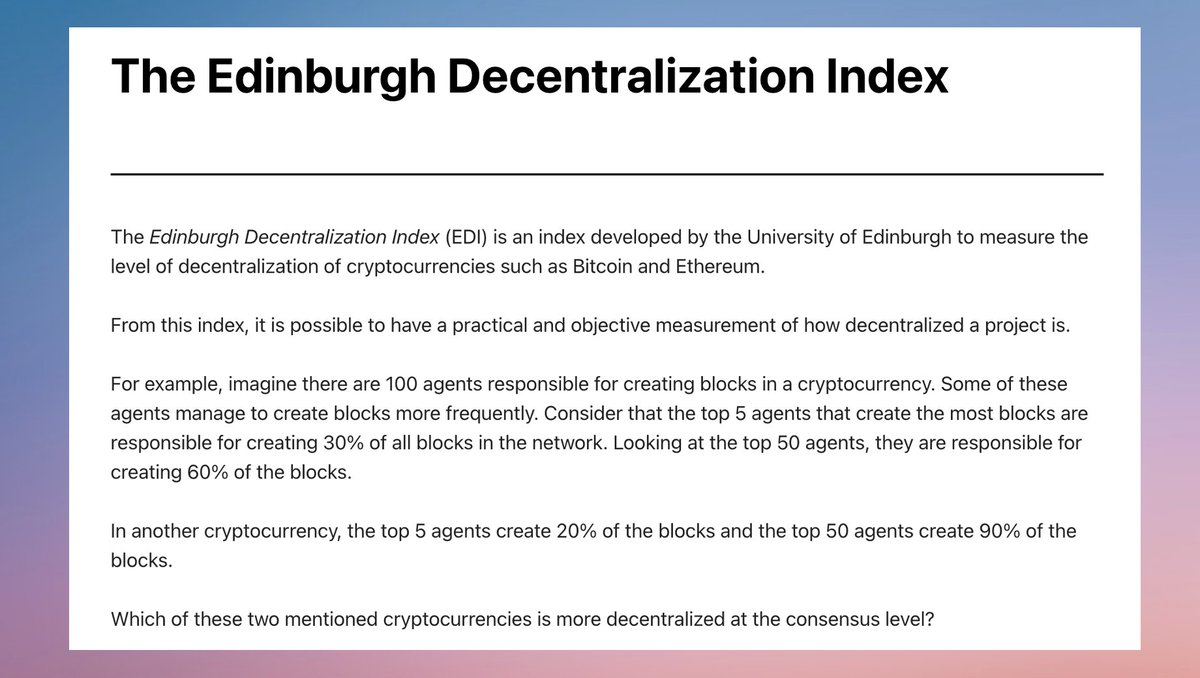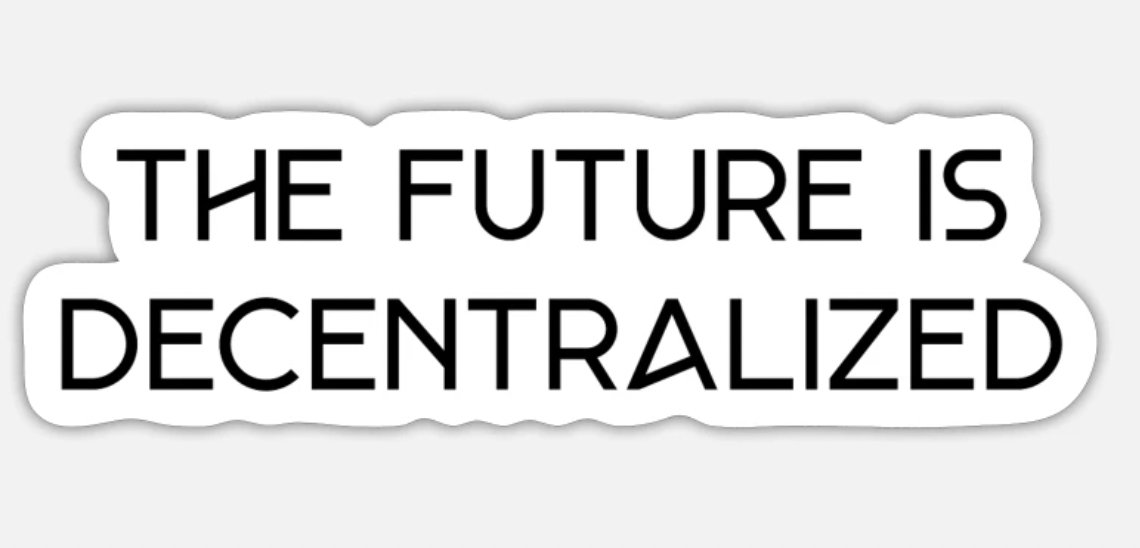
#CardanoCommunity is the most active out there
To further spread the word about #Cardano & #Decentralization, we need to make fundamental comparisons
Cause u only understand a blockchain's value by comparing it to others
Here is an analysis of fundamental metrics of #Polkadot
To further spread the word about #Cardano & #Decentralization, we need to make fundamental comparisons
Cause u only understand a blockchain's value by comparing it to others
Here is an analysis of fundamental metrics of #Polkadot
Crypto is an emerging asset class of the 21st century.
And when making investment decisions in this particular asset class,
it is important not to base them on hype or ever-changing narratives.
#FollowTheMetricsNotTheHype
And when making investment decisions in this particular asset class,
it is important not to base them on hype or ever-changing narratives.
#FollowTheMetricsNotTheHype
So let's take a look at 3 metrics areas of #Polkadot
to better understand it's
1/ Decentralization
2/ Security &
3/ Scalability
to better understand it's
1/ Decentralization
2/ Security &
3/ Scalability
1/Decentralisation
- Initial Token Distribution:
Polkadot had an initial token distribution
with 47 % going towards insiders & the foundation.
Compared to other Layer 1 chains like #Ethereum & #Cardano,
the token allocation for insiders is high.
- Initial Token Distribution:
Polkadot had an initial token distribution
with 47 % going towards insiders & the foundation.
Compared to other Layer 1 chains like #Ethereum & #Cardano,
the token allocation for insiders is high.
For perspective:
#Ethereum & #Cardano distributed around 80% of their tokens through a public sale.
Compared to L1s like #Solana & #Avalanche,
#Polkadot allocated 53% to the public
whereas Solana just distributed 1% and Avalanche allocated 16%.
#Ethereum & #Cardano distributed around 80% of their tokens through a public sale.
Compared to L1s like #Solana & #Avalanche,
#Polkadot allocated 53% to the public
whereas Solana just distributed 1% and Avalanche allocated 16%.

So overall,
the fairness and decentralization of Polkadot's initial token distribution
ranges somewhere between Cardano & Avalanche.
the fairness and decentralization of Polkadot's initial token distribution
ranges somewhere between Cardano & Avalanche.
- The number of individual staked wallets & staking ratio
Polkadot has over 33,646 staked wallets (called Nominators)
with a staking ratio of 52,4%.
Reflecting a relatively low level of decentralization.
Polkadot has over 33,646 staked wallets (called Nominators)
with a staking ratio of 52,4%.
Reflecting a relatively low level of decentralization.

- Permissioned vs Permissionless Node (Yes/No):
Polkadot is a permissionless public blockchain
Polkadot is a permissionless public blockchain
- Total number of active validator nodes/relay nodes/stake pools:
Polkadot has a total of 998 validators.
Although anyone can run a Polkadot validator node,
the maximum number of validators who can participate in the validation i
s restricted to 297 in an Epoch (24 hrs)
Polkadot has a total of 998 validators.
Although anyone can run a Polkadot validator node,
the maximum number of validators who can participate in the validation i
s restricted to 297 in an Epoch (24 hrs)
Compared with Cardano, which has more than 3.100 validator nodes,
Polkadot has a relatively low number of validators.
This reflects a relatively low degree of decentralization.
Polkadot has a relatively low number of validators.
This reflects a relatively low degree of decentralization.

Factors Enabling Decentralization:
- Size of a full node:
Polkadot has 3 history modes of a node:
1/ Full Node: a pruned node that retains the last 256 blocks
- Size of a full node:
Polkadot has 3 history modes of a node:
1/ Full Node: a pruned node that retains the last 256 blocks
2/ Light node: has only runtime & current state, but doesn't store past blocks
3/ Archive Node: retains all block history for the chain.
3/ Archive Node: retains all block history for the chain.
- Minimum hardware & connectivity requirements (see image):
Polkadot relies on validator nodes with modest requirements.
Caveat:
Locking 5.000 DOT ($38.500) as a minimum requirement for running a mainnet validator node is quite a drawback.
Polkadot relies on validator nodes with modest requirements.
Caveat:
Locking 5.000 DOT ($38.500) as a minimum requirement for running a mainnet validator node is quite a drawback.

Security
General Security Metrics:
- Cost of 51% attacks:
For an attacker to control 51% of the Polkadot network,
it will cost over $4.5 billion,
not factoring in the price appreciation that will occur
with a buyer trying to purchase that much DOT.
General Security Metrics:
- Cost of 51% attacks:
For an attacker to control 51% of the Polkadot network,
it will cost over $4.5 billion,
not factoring in the price appreciation that will occur
with a buyer trying to purchase that much DOT.
- Vulnerability to denial-of-service (DoS) & distributed denial-of-service (DDoS) attacks:
Polkadot has a low vulnerability to such attacks
Polkadot has a low vulnerability to such attacks
- Propagation network types (a peer-to-peer propagation network or a relay propagation)
Polkadot has a Peer-to-Peer propagation network.
Polkadot has a Peer-to-Peer propagation network.
Factors Enabling Security:
- Full Node/Partial Node Ratio
The 3 different history modes of a Polkadot node
allow for a high Full node/partial node ratio.
- Full Node/Partial Node Ratio
The 3 different history modes of a Polkadot node
allow for a high Full node/partial node ratio.
- Client Diversity:
Polkadot has three different client implementations in
- Rust
- C++
- and Go languages
Polkadot has three different client implementations in
- Rust
- C++
- and Go languages
3/ Scalability
General Scalability Metrics:
- Transaction throughput:
Regardless of how much throughput Polkadot generates as a whole,
fees will be limited by the throughput capacity of a single parachain
which is about 1000-1500 TPS.
General Scalability Metrics:
- Transaction throughput:
Regardless of how much throughput Polkadot generates as a whole,
fees will be limited by the throughput capacity of a single parachain
which is about 1000-1500 TPS.
This high throughput capacity is achieved
due to the parallel processing of transactions across multiple chains
due to the parallel processing of transactions across multiple chains
For comparison,
the pre-upgraded Ethereum could produce about 13.4 TPS.
And Cardano is performing 7-8 TPS,
which is both very low for an L1.
the pre-upgraded Ethereum could produce about 13.4 TPS.
And Cardano is performing 7-8 TPS,
which is both very low for an L1.
- Transaction latency & finality time:
Complete finality of a transaction might take up to 60 seconds
for a Parachain transaction,
and a few seconds less for a Relay Chain transaction.
Complete finality of a transaction might take up to 60 seconds
for a Parachain transaction,
and a few seconds less for a Relay Chain transaction.
- Active Layer 2s (rollups/state channels):
Polkadot’s goal is to scale horizontally using Parachains
There is the main Relay Chain and subsequent Parachains.
In founder Gavin Wood’s words “Polkadot is a protocol of protocols”
Polkadot’s goal is to scale horizontally using Parachains
There is the main Relay Chain and subsequent Parachains.
In founder Gavin Wood’s words “Polkadot is a protocol of protocols”
The Polkadot network facilitates cross-chain communication
& enables interoperability
by connecting multiple blockchains into one unified network.
Currently, Polkadot has 25 active Parachains
& enables interoperability
by connecting multiple blockchains into one unified network.
Currently, Polkadot has 25 active Parachains

Factors Enabling Scalability:
- Status of data availability that enables rollups:
Polkadot's scaling model is not a rollup-centric one.
Instead, it focuses on creating a scalable multi-chain ecosystem with Parachains.
- Status of data availability that enables rollups:
Polkadot's scaling model is not a rollup-centric one.
Instead, it focuses on creating a scalable multi-chain ecosystem with Parachains.
So what does now the overall verdict look like:
- Decentralization: Low-moderate
- Security: High
- Scalability: Moderate
- Decentralization: Low-moderate
- Security: High
- Scalability: Moderate
Polkadot is a secure L0/L1.
It shows a relatively low-moderate degree of decentralization in its token distribution
& in the number of validators compared to public blockchains like Cardano.
It shows a relatively low-moderate degree of decentralization in its token distribution
& in the number of validators compared to public blockchains like Cardano.
The horizontal scaling model of Polkadot seems to be restricted by the number of Parachains
that shares security with the relay chain.
This might become a critical limitation in a longer time horizon,
where rollups could dominate the scaling solution landscape.
that shares security with the relay chain.
This might become a critical limitation in a longer time horizon,
where rollups could dominate the scaling solution landscape.
After those quantitative metrics let's have a look at some qualitative metrics:
- The team behind #Polkadot
- Social Sentiment
- Accounting model
- Current State of DeFi
- The team behind #Polkadot
- Social Sentiment
- Accounting model
- Current State of DeFi
The Team:
Polkadot was founded by Dr. Gavin Wood (a co-founder of Ethereum)
alongside co-founders Peter Czaban & Robert Habermeier in 2016.
The Web3 Foundation is the non-profit that conducted Polkadot’s token sales, where Gavin is its President.
Polkadot was founded by Dr. Gavin Wood (a co-founder of Ethereum)
alongside co-founders Peter Czaban & Robert Habermeier in 2016.
The Web3 Foundation is the non-profit that conducted Polkadot’s token sales, where Gavin is its President.
The first token sale in Oct. 2017, raised $145 million in just under 2 weeks,
selling 50% of the initial 10 million DOT (old) supply.
A wallet hack on Nov 17 contained over 500,000 ETH,
including $98 million of the $145 million in ETH raised through the Polkadot ICO.
selling 50% of the initial 10 million DOT (old) supply.
A wallet hack on Nov 17 contained over 500,000 ETH,
including $98 million of the $145 million in ETH raised through the Polkadot ICO.

Social
The Social Engagemnet and Sentiment of Polkadot experienced a bit of a downturn.
This could be due to Merge and Fork Events of #ETH & #ADA catching the attention of the community
or the overall macro situation.
The Social Engagemnet and Sentiment of Polkadot experienced a bit of a downturn.
This could be due to Merge and Fork Events of #ETH & #ADA catching the attention of the community
or the overall macro situation.

Accounting Model:
Polkadot allows for both
an account-based model & unspent transaction output- model (UTXO).
The current framework enables the implementation of
an account based model on Polkadot Relay chains
but it can support a UTXO Parachian, theoretically in the future
Polkadot allows for both
an account-based model & unspent transaction output- model (UTXO).
The current framework enables the implementation of
an account based model on Polkadot Relay chains
but it can support a UTXO Parachian, theoretically in the future
Current State of DeFi.
Polkadots Ecosystem of Parachains continues to grow.
In August, @AstarNetwork partnered with @AcalaNetwork to boost DeFi
by creating opportunities & rewards for developers in the ecosystem.
Polkadots Ecosystem of Parachains continues to grow.
In August, @AstarNetwork partnered with @AcalaNetwork to boost DeFi
by creating opportunities & rewards for developers in the ecosystem.

@AstarNetwork @AcalaNetwork That's a wrap!
If you enjoyed this thread:
1. Follow me @DiMoneymindset for more of these
2. RT the tweet below to share this thread with your audience
If you enjoyed this thread:
1. Follow me @DiMoneymindset for more of these
2. RT the tweet below to share this thread with your audience
https://twitter.com/DiMoneymindset/status/1573602763744940036
If you like Tweets like this, you might enjoy our weekly newsletter: Just The Metrics.
A 5-minutes, easy-to-understand newsletter about crypto fundamentals to stay up to date & be better crypto investors 📈
Subscribe here👇
…st-the-metrics-newsletter.beehiiv.com
A 5-minutes, easy-to-understand newsletter about crypto fundamentals to stay up to date & be better crypto investors 📈
Subscribe here👇
…st-the-metrics-newsletter.beehiiv.com
• • •
Missing some Tweet in this thread? You can try to
force a refresh







